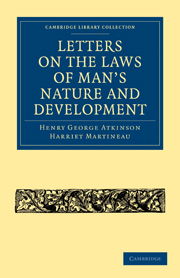Book contents
- Frontmatter
- Preface
- Mottoes
- Contents
- Letter. 1 Inquiry for a Basis
- Letter. 2 Proposal of a Basis
- Letter. 3 Preparation of the Ground
- Letter. 4 What is the Brain?
- Letter. 5 Inquiry about its Structure
- Letter. 6 Early days of Phrenology
- Letter. 7 Inquiry for New Discoveries
- Letter. 8 Methods of New Discovery. Organic Arrangement of the Brain
- Letter. 9 Illustrative Cases
- Letter. 10 Organic Arrangement of the Cerebrum
- Letter. 11 Dr. Howe's Report on Idiocy
- Letter. 12 The Senses and Nervous System
- Letter. 13 Illustrative Comment
- Letter. 14 Facts about the Senses under various conditions
- Letter. 15 Raising questions
- Letter. 16 Bacon, on Matter and Causation. Inferences and Dreams. Association of Ideas
- Letter. 17 Nothing
- Letter. 18 Knowledge and Notions. Results of each
- Letter. 19 Release from Notions. Entrance upon Knowledge
- Letter. 20 Natural History of Superstition
- Letter. 21 Theology and Science
- Letter. 22 Central Law and Pervasive Unity. Light. Sense of Identity. Ghost-seeing. Unrevealed Human Relations
- Letter. 23 Position and Privilege of Truth-seekers
- Letter. 24 Position and Privilege of Truth-speakers
- Appendix
Letter. 21 - Theology and Science
Published online by Cambridge University Press: 29 August 2010
- Frontmatter
- Preface
- Mottoes
- Contents
- Letter. 1 Inquiry for a Basis
- Letter. 2 Proposal of a Basis
- Letter. 3 Preparation of the Ground
- Letter. 4 What is the Brain?
- Letter. 5 Inquiry about its Structure
- Letter. 6 Early days of Phrenology
- Letter. 7 Inquiry for New Discoveries
- Letter. 8 Methods of New Discovery. Organic Arrangement of the Brain
- Letter. 9 Illustrative Cases
- Letter. 10 Organic Arrangement of the Cerebrum
- Letter. 11 Dr. Howe's Report on Idiocy
- Letter. 12 The Senses and Nervous System
- Letter. 13 Illustrative Comment
- Letter. 14 Facts about the Senses under various conditions
- Letter. 15 Raising questions
- Letter. 16 Bacon, on Matter and Causation. Inferences and Dreams. Association of Ideas
- Letter. 17 Nothing
- Letter. 18 Knowledge and Notions. Results of each
- Letter. 19 Release from Notions. Entrance upon Knowledge
- Letter. 20 Natural History of Superstition
- Letter. 21 Theology and Science
- Letter. 22 Central Law and Pervasive Unity. Light. Sense of Identity. Ghost-seeing. Unrevealed Human Relations
- Letter. 23 Position and Privilege of Truth-seekers
- Letter. 24 Position and Privilege of Truth-speakers
- Appendix
Summary
H. M. to H. G. A.
Ah! how true it is that Christianity has not, as you say, Christianized the world! There is something curious in the spectacle of the embarrassment of every sect of Christians in accounting for this fact. I know no subject on which there is more miserable floundering among incompatible views and untenable assertions. From those who, with a foregone conclusion, set about estimating how much Christianity has done for the world, to those who give the matter up, and declare the delay to be a mystery of Providence, I find none with whom I can for a moment agree. To me, the wonder would be if it had Christianized the world. Its unfitness for saving the race,—for an universal reception by mankind,—seems to be shown clearly enough by the rise of Mohammedanism, and by the spread of that faith so far beyond the extent that Christianity ever attained as to include, in our day, a fifth part of the whole human race. That religion, imperfect as we see it to be, met needs and gratified faculties, among certain races of men, which Christianity wholly neglected. We are not of the races whose needs could be met by Mohammedanism: nor are we supplied, even on the most superficial view, by what Christianity offers us. As the omission of a provision for the antagonistic at once with the fatalistic faculties of men made Mohammedanism necessary, so the neglect, amounting to discountenance, by Christ, of the domestic passions and affections, nullifies its operation with us.
- Type
- Chapter
- Information
- Letters on the Laws of Man's Nature and Development , pp. 244 - 251Publisher: Cambridge University PressPrint publication year: 2009First published in: 1851

